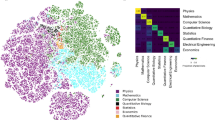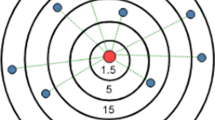Abstract
In this paper we have looked at a new measure of connectedness between research areas, namely, the migration of authors between subfields as seen from their contributions to different areas. Migration may be considered as an embodied knowledge flow that bridges some part of the cognitive gap between fields. Our hypothesis is that the rate of author migration will reflect cognitive similarity or affinity between disciplines. This is graphically shown to be reasonable, but only above certain levels of migration for our data from mathematical reviews spanning 17 years (1959–1975). The inter-related structure of Mathematics is then mapped using migration data in the appropriate range. We find the resulting map to be a good reflection of the disciplinary variation in the field of Mathematics.





Similar content being viewed by others
References
Basu, A. (2005). Social network analysis of terrorist organizations in India: Proceedings of NAACSOS Conference 2005, June 26–28, 2005, Notre Dame, Indiana, USA.. http://www.casos.cs.cmu.edu/events/conferences/2005/2005_proceedings/Basu.pdf. Retrieved on 2 Jan 2012.
Basu, A. (2011). Mapping the network of mathematics using ‘cognitive mobility’ or migration of authors between fields as an index. In: E. Noyons, P. Ngulube, & J. Leta (Eds.), Proceeding of ISSI 2011—The 13th International Conference on Scientometrics and Informetrics, Durban, South Africa, 4–7 July 2011 (pp. 99–110).
Borgatti, S. P., Everett, M. G., & Freeman, L. C. (2002). UCINET: Software for social network analysis. Harvard: Analytic Technologies.
Boyack, K. W., & Klavans, R. (2010). Co-citation analysis, bibliographic coupling, and direct citation: Which citation approach represents the research front most accurately? Journal of the American Society for Information Science and Technology, 61(12), 2389–2404.
Callon, M., Law, J., & Rip, A. (Eds.). (1986). Mapping the dynamics of science and technology: Sociology of science in the real world. London: Macmillan Press.
Chen, C. M. (2008). Classification of scientific networks using aggregated journal–journal citation relations in the Journal Citation Reports. JASIST, 2296, 2304.
Chen, C., McCain, K.W., White, H., & Lin, X. (2002). Mapping Scientometrics (1981–2001), Proceedings of the American Society for Information Science and Technology (Vol. 39, pp. 25–34).
Gibbons, M., Imoges, C., Nowotny, H., Schwartzman, S., Scott P., & Trow, M. (1994). The new production of knowledge: The dynamics of science and research in contemporary societies (Sage).
Leydesdorff, L. (2006). Can scientific journals be classified in terms of aggregated journal–journal citation relations using the Journal Citation Reports? Journal of the American Society for Information Science and Technology, 57(5).
Leydesdorff, L. (2008). Patent classifications as indicators of intellectual organization. Journal of the American Society for Information Science and Technology, 59(10), 1582–1597.
Leydesdorff, L., de Moya Anegón, F., & Guerrero Bote, V. P. (2010). Journal maps on the basis of scopus data: A comparison with the journal citation reports of the ISI. JASIST, 61(2), 352–369.
Leydesdorff, L., & Salah, A. A. A. (2010). Maps on the basis of the Arts & Humanities Citation Index: The journals Leonardo and Art Journal versus “digital humanities” as a topic. JASIST, 61(4), 787–801.
Leydesdorff, L., & Schank, T. (2008). Dynamic animations of journal maps: Indicators of structural changes and interdisciplinary developments. JASIST, 59(11), 1810–1818.
Small, H. (1973). Cocitation in scientific literature: New measure of relationship between two documents. Journal of The American Society For Information Science, 24(4), 265–269.
Small, H. (1994). Map case-study—Building a map of AIDS research. Scientometrics, 30(1), 1–229.
Small, H. (1999). Visualizing science by citation mapping. JASIS, 50(9), 799–813.
Small, H. (2009). Critical thresholds for co-citation clusters and emergence of the giant component. Journal of Informetrics, 3(4), 332–340.
Small, H. (2010). Maps of science as interdisciplinary discourse: co-citation contexts and the role of analogy. Scientometrics, 83(3), 835–849.
Waaijer, C. J. F., van Bochove, C. A., & van Eck, N. J. (2011). On the map: Nature and science editorials. Scientometrics, 86, 99–112.
Wagner Dobler, R. (1999). Cognitive mobility: A macroscopic investigation of migration of scientists between research fields studied by example of mathematics. In P. S. Nagpaul, K. C. Garg, B. M. Gupta, S. Bhattacharya, A. Basu, P. Sharma, & S. Kumar (Eds.), Emerging trends in scientometrics (pp. 225–241). New Delhi: Allied Publishers.
White, H. D. (2003). Pathfinder networks and author co-citation analysis: A remapping of paradigmatic information scientists. JASIST, 54(5), 423–434.
White, H. D., & McCain, K. W. (1998). Visualizing a discipline: An author co-citation analysis of information science, 1972–1995. JASIS, 49(4), 327–355.
Author information
Authors and Affiliations
Corresponding author
Appendix
Appendix
See Table 4.
Rights and permissions
About this article
Cite this article
Basu, A., Dobler, R.W. ‘Cognitive mobility’ or migration of authors between fields used in mapping a network of mathematics. Scientometrics 91, 353–368 (2012). https://doi.org/10.1007/s11192-011-0613-5
Received:
Published:
Issue Date:
DOI: https://doi.org/10.1007/s11192-011-0613-5




